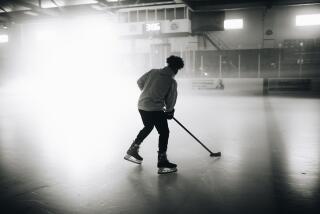A consumer’s guide to the best and worst of sports media and merchandise. Ground rules: If it can be read, played, heard, observed, worn, viewed, dialed or downloaded, it’s in play here.
- Share via
What: “The Ultimate Bad Boys,” by Stan Fischler
Price: $15.95, Warwick Publishing
First, a confession in the interest of journalistic integrity.
While in high school, I worked for Stan Fischler. I did research, made phone calls and wrote chapters of a few of his books. (Go ahead, ask me anything about Ed Van Impe of the Philadelphia Flyers.) My compensation was a couple of subway tokens per visit and an acknowledgment in the foreword of his books, usually with my name misspelled.
Which leads me to why I’m so leery of--and disappointed by--this offering by one of the most prolific hockey writers ever to enter a rink.
This book is, essentially, a compilation of interviews conducted by his corps of researchers and free-lance writers, which he calls the Fischler Hockey Service. None is a sportswriter or trained journalist. None has Fischler’s writing experience or has watched hockey as long as he has.
What’s missing from their efforts is Fischler’s perspective. He says in the introduction some of the game’s “most interesting and downright exciting moments have come from such colossal battles as Gordie Howe vs. Lou Fontinato, Rocket Richard vs. Bob Dill and Bill Ezinicki vs. Ted Lindsay,” but he stops short of analyzing what that says about the game. In his lifetime of covering hockey, he must have seen a variety of attitudes toward fighting, from the reign of Philadelphia’s Broad Street Bullies to attempts by the NHL to eliminate bench-clearing brawls--and, more recently, Toronto General Manager Ken Dryden’s proposals to ban fighting. Discussing the changing viewpoints from era to era would have been enlightening, but that’s not here.
Too often, the chapters consist of a transcript of a question-and-answer session conducted by one of Fischler’s assistants. If you’re going to follow that format, the questions should be better than “Where were you born?” That’s listed in the NHL Guide. Ask something people might not know or can’t easily discover. As for the nearly 50-page chapter in which Randall S. Chadwick, David Singer and Joe Lozito rate NHL enforcers, who are Randall S. Chadwick, David Singer and Joe Lozito besides hockey fans and friends of Fischler’s who watch a lot of fight tapes? What makes them experts whose expertise is worth $15.95? And why didn’t someone curb their gushing descriptions of players and eliminate some of the exclamation points?
In other chapters, players recount their stories in a kind of stream of consciousness, and those sections are affecting. Players emerge as human and surprisingly eloquent. “I don’t try to wreck anyone’s career,” Bryan Marchment says--a statement that might be challenged by players who have needed knee surgery after encounters with Marchment’s outstretched leg. “But that doesn’t mean I don’t go out on the ice and try to be as rough as I can be. I would be lying if I said it wasn’t. . . . One thing I wanted everyone to be damned sure about is the fact that I’ll give out physical play and I will take it but maybe the opponent is going to get it worse than me.”
King left wing Matt Johnson recounted his first hockey fight, which occurred in a peewee game when he was 12 after an opponent had run his team’s goalie. “It was a weird scene for a couple of reasons,” he says. “Number one: the fellow who dumped our goalie was a friend of mine even though he played for the other team. Number two: our fathers were sitting next to each other in the stands, watching the game. Anyway, we dropped the gloves and fought. The funny thing was that while we were fighting, our dads were just sitting there talking. To me, that was kind of strange.”
The book also includes lists of Kayo Kings of the Decade and the All-Dirtiest-Toughest team, which might spark some discussion among hockey fight fans. However, the overall effort is not worth the purchase price. The topic is interesting, but it could have been covered with more insight, historical perspective and energy. Fischler has done hockey books that were thought-provoking, but this one seems thrown together and bears the imprint of too many others to call his.
More to Read
Go beyond the scoreboard
Get the latest on L.A.'s teams in the daily Sports Report newsletter.
You may occasionally receive promotional content from the Los Angeles Times.





